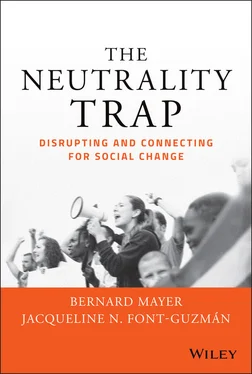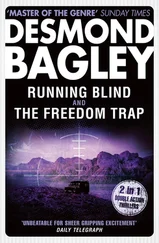Bernard S. Mayer - The Neutrality Trap
Здесь есть возможность читать онлайн «Bernard S. Mayer - The Neutrality Trap» — ознакомительный отрывок электронной книги совершенно бесплатно, а после прочтения отрывка купить полную версию. В некоторых случаях можно слушать аудио, скачать через торрент в формате fb2 и присутствует краткое содержание. Жанр: unrecognised, на английском языке. Описание произведения, (предисловие) а так же отзывы посетителей доступны на портале библиотеки ЛибКат.
- Название:The Neutrality Trap
- Автор:
- Жанр:
- Год:неизвестен
- ISBN:нет данных
- Рейтинг книги:3 / 5. Голосов: 1
-
Избранное:Добавить в избранное
- Отзывы:
-
Ваша оценка:
- 60
- 1
- 2
- 3
- 4
- 5
The Neutrality Trap: краткое содержание, описание и аннотация
Предлагаем к чтению аннотацию, описание, краткое содержание или предисловие (зависит от того, что написал сам автор книги «The Neutrality Trap»). Если вы не нашли необходимую информацию о книге — напишите в комментариях, мы постараемся отыскать её.
The Neutrality Trap,
The Neutrality Trap
The Neutrality Trap — читать онлайн ознакомительный отрывок
Ниже представлен текст книги, разбитый по страницам. Система сохранения места последней прочитанной страницы, позволяет с удобством читать онлайн бесплатно книгу «The Neutrality Trap», без необходимости каждый раз заново искать на чём Вы остановились. Поставьте закладку, и сможете в любой момент перейти на страницу, на которой закончили чтение.
Интервал:
Закладка:
Martin Luther King's vision of a Beloved Community has been an important source of strength for the civil rights and Black Lives Matter movements. The Beloved Community provides a picture of a non‐exploitative, nonviolent society, but it says little about the social, political, and economic arrangements that would actualize and sustain this vision. Dr. King believed that a radical commitment to nonviolence and social justice was the path to putting this vision into practice.
There has been no shortage of other contending visions and ideologies: anarchism, liberation theology, radical feminism, and communitarianism, to name a few. It's not our purpose to suggest what vision should or will take hold. Our sense is that ultimately some of the values and ideas of many of these ideologies will have to be part of the long‐term vision of progressive movements if they are to address the challenges we face at their most fundamental level.
What seems clear is that having a hopeful but realistic vision of the world we are striving for, a vision that takes us beyond our immediate struggles or particular focus, is part of what makes fundamental change possible. Such a vision is more likely if we can point to societies that have had at least some success in walking down this road. We can look to social democratic systems (e.g. Sweden or Finland) or countries that have achieved some success in pursuing multiculturalism (e.g. New Zealand or Canada) as partial examples. But these are not perfect examples because they are culturally specific models that will not necessarily work in other contexts, are themselves flawed, and were not designed to deal with problems that are truly global in scale.
This lack of a clear and comprehensive vision for social movements is also in some respects a good thing. Rigid ideologies or movements that have attached themselves to the example of a particular society (China, Cuba, or the Soviet Union, for example) have failed to provide an effective vision, have been political failures, and most importantly have ended up being morally compromised.
Instead, we need to think of a long‐term vision as a process rather than an outcome. The search for a comprehensive vision that is consistent with our values, connected to our actions, and hopeful but also realistic is an essential part of effective social movements. Such a search must be iterative, informed by experience and values, based on a continuous effort to understand our social, political, and economic systems, and inclusive of diverse people and communities.
The following chapters look at both the obstacles we face and strategies we can employ to promote social change. The book focuses on three essential challenges, which together form the steppingstones for system change: productive approaches to conflict engagement, deepening conflict, and system disruption. We start by considering a significant ideological cultural obstacle posed by the intellectual foundation that informs the work of many professions and institutions, including that of conflict interveners and the justice system—the ideology of neutrality.
Reflective Dialogue: What Keeps Us Going
Writing a book of this nature requires an ongoing reflective process. Both of us have carried this on individually but also together as we have sought to consolidate our thinking about how social conflict can unfold in a powerful and meaningful way. We have drawn on all that we have learned from our own practice as students and practitioners of conflict engagement and from our history as activists. We will end some chapters with a brief dialogue between us about how our thinking has evolved and what this has meant for our work on conflict and social change .
Bernie: Jackie, as we prepared different drafts of this chapter, each of us discussed the tension between being realistic about the difficulty of achieving profound social change while remaining optimistic about the profound power of collective action to change society. I have often said that optimism is a moral obligation, but optimism that is not grounded in a realistic view of the challenges we face is neither authentic nor useful. Integrating optimism and realism is an ongoing personal and professional challenge. What I find helps, in fact is required, is to embrace uncertainty. We don't know for sure what the future holds; we know we face real challenges, and to be convinced all will be well makes no sense—but neither does being sure that all is lost and we are doomed. I hold onto both uncertainty and a lifetime of experience in seeing people, groups, and societies change in response to social action. What is your take on the potential to disrupt, dismantle, rebuild, and sustain healthier and more just social structures?
Jackie: Bernie, I have never given up hope that we can create systems and institutional structures in which we can share and celebrate our common humanity. When I look back at what moves me and sustains my hope, it always comes down to love—the love that allows me to be present for others, see the unseen, and disrupt spaces in which injustice has been normalized. During my litigation years in Puerto Rico, a significant part of my practice was representing (in non‐criminal cases) clients who were involuntarily or voluntarily confined in custodial, correctional, healthcare, or penal institutions. I made many visits to these institutions to meet with my clients. I never imagined I could see and experience so much love in a system that was ingrained with so much violence and abuse.
One rainy morning, as I was driving to the parking area of a penal institution, I saw a woman trudging up the hill clutching a stuffed paper bag. (Lawyers could drive up the hill, other visitors had to walk about a quarter of a mile.) She was probably in her late 50s, had no umbrella, and was wearing a worn‐out dress. It looked like the real weight she was carrying was the one on her shoulders. I remember feeling sadness and indignation while thinking—she is most likely someone's mother or grandmother. Her exhaustion and pain were evident, but so was her love. She, unknowingly, made me see the injustice of institutional procedures that hindered the ability of prisoners to be visited by their loved ones. It was also a reminder of our interconnectedness; no matter how much unjust structures try to “place people out of sight,” we are all still connected. Seeing with love is what allows me to feel the indignation that moves me toward confronting unjust systems and building more just social structures.
Bernie, doing this work is difficult, emotionally draining, and many times is unappreciated. What moves you to persevere?
Bernie: For me too, the love, caring, and connectedness that are at the heart of social movements are important sources of hope and energy. But I also feel that sometimes anger at what I see happening is an important motivator as well. We are told in so many ways that profound change is hopeless—that racism has always been with us and always will be, that inequality is inevitable, that climate change can't be avoided so we should just adapt (or deny), and that our actions of resistance are only going to be met by powerful pushback. It sometimes seems safer to be pessimistic and cynical than hopeful. That really makes me angry. I refuse to give in to hopelessness. But this is not just an emotional reaction. I really do believe that progress will be made.
We are in the midst of the COVID‐19 pandemic that has brought a sense of gloom and pessimism to all of us. The election that we have just been through, the concerted and frightening efforts that have been taken to call into question the results that ousted a would‐be dictator, and the incredible numbers of voters who supported him despite his overt racism, authoritarianism, misogynism, and incompetence are all reasons to have doubts about our future.
Читать дальшеИнтервал:
Закладка:
Похожие книги на «The Neutrality Trap»
Представляем Вашему вниманию похожие книги на «The Neutrality Trap» списком для выбора. Мы отобрали схожую по названию и смыслу литературу в надежде предоставить читателям больше вариантов отыскать новые, интересные, ещё непрочитанные произведения.
Обсуждение, отзывы о книге «The Neutrality Trap» и просто собственные мнения читателей. Оставьте ваши комментарии, напишите, что Вы думаете о произведении, его смысле или главных героях. Укажите что конкретно понравилось, а что нет, и почему Вы так считаете.












